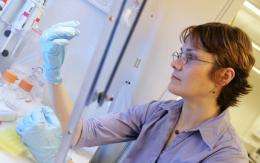A search for life at the Earth's extremes

(�鶹��ԺOrg.com) -- A USC scientist will take a research expedition this month into the heart of the Mid-Atlantic Ocean to explore the very limits of life on Earth.
Katrina Edwards of USC Dornsife and Wolfgang Bach of Bremen University will co-lead the team of more than 100 scientists and support crew on a drilling expedition for the Center for Dark Energy Biosphere Investigations (C-DEBI), which is systematically working to unlock the secrets of the living world below the seafloor.
While leading the trip, Edwards will blog about the team’s experiences so that the public can follow the expedition as it unfolds. That blog will be published on the Scientific American website at blogs.scientificamerican.com/expeditions and on the C-DEBI website at darkenergybiosphere.org/return-to-northpond .
“We don’t understand most of this planet,” said Edwards, professor of biological sciences, Earth sciences and environmental studies. “We know more about the surfaces of other planets in the solar system than we do about the ocean floor.”
Edwards and her team will depart on Sept. 16 and spend about two months drilling at a site known as the North Pond, a shallow bowl of sediment on the Mid-Atlantic Ridge. The team will drill well past the sediment layer and into the solid rock below it to collect microbes in its search for the bottom of the biosphere - the portion of the Earth that is inhabited by living organisms.
“The North Pond is perfect because it is perfectly average” and has seen scientists of all stripes recording various data about it for the past 40 years, Edwards said. “We’re building on a great history of research.”
About one-third of the world’s biomass is thought to exist below the ocean floor and has seen little scientific study to date. Edwards’ expedition is part of a multi-year effort to explore this untapped world; she plans to continue collecting data at the North Pond over the next five years.
Edwards' goal is to learn more about the role that tiny subseafloor microbes play in shaping the oceans and crust of the Earth. Current evidence suggests that, despite their size, they could be a major factor shaping massive oceanic features. At this point, however, scientists desperately need more raw data to know just how major.
The two-month expedition will be challenging - and will be the longest Edwards has been at sea. Before this, she spent one month in 2009 at the same site, scouting the location in preparation for this expedition.
“It’s five days to get there and five days back. Even a ‘short’ trip takes a while,” she said.
Provided by USC College

















